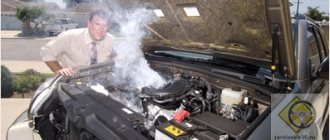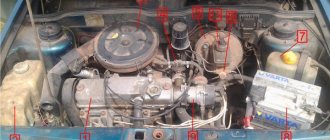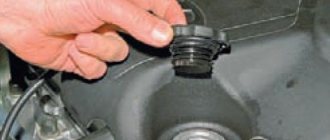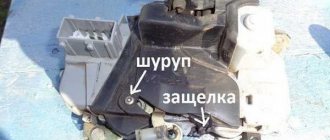engine overheating (Lada Kalina)
Because
You are not logged in. To come in. Because you are not a trust user. How to become a trustee.
Because The topic is archived.
The engine has overheated, judging by your words.
On the engine temperature. And if you dig deeper, then to the cooling system.
In general, you need service. Otherwise you’ll just beeping in traffic jams.
Because You are not logged in. To come in.
Because you are not a trusted user (phone number is not verified). Enter and confirm your phone number. Read more about trusts.
Because The topic is archived.
Because You are not logged in. To come in.
Because you are not a trusted user (phone number is not verified). Enter and confirm your phone number. Read more about trusts.
Because The topic is archived.
Because You are not logged in. To come in.
Because you are not a trusted user (phone number is not verified). Enter and confirm your phone number. Read more about trusts.
Because The topic is archived.
Because You are not logged in. To come in.
Because you are not a trusted user (phone number is not verified). Enter and confirm your phone number. Read more about trusts.
Because The topic is archived.
Because You are not logged in. To come in.
Because you are not a trusted user (phone number is not verified). Enter and confirm your phone number. Read more about trusts.
Because The topic is archived.
Because You are not logged in. To come in.
Because you are not a trusted user (phone number is not verified). Enter and confirm your phone number. Read more about trusts.
Because The topic is archived.
Because You are not logged in. To come in.
Because you are not a trusted user (phone number is not verified). Enter and confirm your phone number. Read more about trusts.
Because The topic is archived.
Because You are not logged in. To come in.
Because you are not a trusted user (phone number is not verified). Enter and confirm your phone number. Read more about trusts.
Because The topic is archived.
Because You are not logged in. To come in.
Because you are not a trusted user (phone number is not verified). Enter and confirm your phone number. Read more about trusts.
Because The topic is archived.
Because You are not logged in. To come in.
Because you are not a trusted user (phone number is not verified). Enter and confirm your phone number. Read more about trusts.
Because The topic is archived.
Because You are not logged in. To come in.
Because you are not a trusted user (phone number is not verified). Enter and confirm your phone number. Read more about trusts.
Because The topic is archived.
Because You are not logged in. To come in.
Because you are not a trusted user (phone number is not verified). Enter and confirm your phone number. Read more about trusts.
Because The topic is archived.
Because You are not logged in. To come in.
Because you are not a trusted user (phone number is not verified). Enter and confirm your phone number. Read more about trusts.
Because The topic is archived.
Because You are not logged in. To come in.
Because you are not a trusted user (phone number is not verified). Enter and confirm your phone number. Read more about trusts.
Because The topic is archived.
Because You are not logged in. To come in.
Because you are not a trusted user (phone number is not verified). Enter and confirm your phone number. Read more about trusts.
Because The topic is archived.
Because You are not logged in. To come in.
Because you are not a trusted user (phone number is not verified). Enter and confirm your phone number. Read more about trusts.
Because The topic is archived.
Because You are not logged in. To come in.
Because you are not a trusted user (phone number is not verified). Enter and confirm your phone number. Read more about trusts.
Because The topic is archived.
Because You are not logged in. To come in.
Because you are not a trusted user (phone number is not verified). Enter and confirm your phone number. Read more about trusts.
Because The topic is archived.
Because You are not logged in. To come in.
Because you are not a trusted user (phone number is not verified). Enter and confirm your phone number. Read more about trusts.
Because The topic is archived.
Because You are not logged in. To come in.
Because you are not a trusted user (phone number is not verified). Enter and confirm your phone number. Read more about trusts.
Because The topic is archived.
Because You are not logged in. To come in.
Because you are not a trusted user (phone number is not verified). Enter and confirm your phone number. Read more about trusts.
Because The topic is archived.
Because You are not logged in. To come in.
Because you are not a trusted user (phone number is not verified). Enter and confirm your phone number. Read more about trusts.
Because The topic is archived.
Because You are not logged in. To come in.
Because you are not a trusted user (phone number is not verified). Enter and confirm your phone number. Read more about trusts.
Because The topic is archived.
Because You are not logged in. To come in.
Because you are not a trusted user (phone number is not verified). Enter and confirm your phone number. Read more about trusts.
Because The topic is archived.
Because You are not logged in. To come in.
Because you are not a trusted user (phone number is not verified). Enter and confirm your phone number. Read more about trusts.
Because The topic is archived.
Because You are not logged in. To come in.
Because you are not a trusted user (phone number is not verified). Enter and confirm your phone number. Read more about trusts.
Because The topic is archived.
Because You are not logged in. To come in.
Because you are not a trusted user (phone number is not verified). Enter and confirm your phone number. Read more about trusts.
Because The topic is archived.
Advertisements on NN.RU – Auto
Wide selection of hydraulic pumps and hydraulic motors of all series. Axial piston hydraulic motor. Splined shaft, reverse rotation. Analogs - (many. Price: 1,000 rub.
With us you can not only extend the frame to fit a body of 5.1 m, 6.2 m, 7.5 m, 9 m for Maz Zubrenok, Maz, Kamaz, Ural, Zil, Mitsubishi, Nissan.
Lengthen Kamaz under a body 7.5 m Lengthen Maz Zubrenok, Maz under a body 9 m Re-equipment of the chassis of an extended truck.
Lengthen Gas 331043, 331063 Valdai-farmer for installation of a body 5.1/6.5 m. The chassis is lengthened by increasing the wheel size.
Source: www.nn.ru
Reasons for engine heating
Cooling system assembly
Quite often you can come across the concept of engine overheating on the Lada Kalina. There are quite a few reasons and they are worth knowing if you want to carry out the repair yourself without resorting to the help of a car service.
The main reason why overheating occurs (4th error on the instrument panel) is a malfunction in the engine cooling system, as well as, in rare cases, accumulated errors in the engine control unit. So, let's look at the main reasons for overheating of the main power unit of the Lada Kalina:
- Clogged engine cooling radiator and cooling lines.
Diagram of the working thermostat. If there is a malfunction, it jams into a small circle, causing the car to become very hot.
Coolant sensor locations
Cleaning the cooling radiator from debris
All these elements are part of the cooling system, which can fail.
Heats up at idle
At idle, the engine gets hot, most likely due to a faulty thermostat or a clogged radiator. Therefore, the reason must be sought here. First, you need to replace the thermostat. This operation is carried out quite easily:
- Drain the coolant through the radiator drain plug.
The drain plug in the radiator is located at the bottom right
Thermostat disassembly diagram
Attention! The new thermostat comes with a gasket that must be installed. For normal manufacturers of spare parts, it is included with the part, so it is worth checking its presence in the box.
- We carry out the assembly in the reverse order.
- Fill in coolant.
Important! When replacing a thermostat, it is recommended to pour completely new fluid into the system, since the wedge of this element can be caused not only by wear of the part, but also by the loss of the physical and chemical properties of the coolant.
Pour coolant into the system through the expansion tank
We warm up the car to operating temperature and test whether the problem is resolved. If not, then you need to remove the cooling radiator, wash it and blow it out. Also, heating can be caused by insufficient liquid, so it’s worth looking to see if a pipe has burst somewhere or if liquid is leaking from the system.
Engine gets hot in traffic jams
A faulty cooling fan can cause your car to heat up in traffic jams. There may be several reasons for this:
- Burnt out cooling fan.
- Failure of the fan control relay.
Replacing the fan relay
Usually, it is in the wire connection block that the contact melts or oxidizes, which leads to an open circuit
Blown cooling fan fuse
Therefore, if the cooling fan does not turn on, you need to look for the reason here.
The second reason for the engine heating up in traffic jams may be a malfunction of the engine cooling thermostat. Replacing it is quite easy and simple, but it may take a lot of time.
Heats up to the red zone
When the engine heats up, when the arrow on the dashboard moves to the red zone, then the thermostat and engine temperature sensor are definitely faulty.
In this case, when the power unit heats up to 100 degrees Celsius, the cooling fan should turn on. If it does not turn on, then you should look for the reason in the fan circuit.
Heating the engine to the red zone
You should not allow the engine to overheat in the red zone, as this can lead to deformation of the cylinder head, gasket breakdown and failure of other elements of the main power units.
Recommendations
Some car enthusiasts recommend installing cooling system tuning kits. It has an increased service life, and due to the improved operation of the thermostat and high-speed pump, the car cools better, which prevents overheating even with frequent use of high speeds.
Installed tuning cooling kit
What is the operating temperature of the Lada Kalina engine?
Normal operating temperature of internal combustion engine: +90. +95, if above +97 then the internal combustion engine will be slightly dulled, but this t is also considered normal, up to +110 is also normal, but the radiator fan should already turn on. If t is below +90, this is not overheating. We look at the thermoelement for grinding into the thermostat cover (so that when closed it does not etch into a large circle) and the serviceability of the thermoelement itself by boiling it in the thermostat cover. If the lower pipe is cold, this is not a fact that it does not poison the large circle.
Here, for example, is my excerpt from the topic: SOD according to Kalinovsky:
I purchased a 6-hole thermostat assembled, sealed, with an Quality Control Department stamp, t 85, PRAMO, for 505 rubles. I also had a thermocouple from a viburnum, also at t 85, lying around for a long time. ___________________________________________
Kalinovsky thermoelement:
__________________________________________________
Thermostat with thermocouple:
__________________________________________________
I boiled both thermoelements in this one housing of the new thermostat, the result:
1. Thermoelement from viburnum: opened slightly at +92 (began to let water through at atmospheric pressure) at 96 opened slightly by 5 mm +100 opened by 8-9 mm diluted the water to +83 - almost instantaneous slamming.
2. Stock thermocouple Pramo: opened slightly at exactly +85 and went at atm. pressure +86 hole mm 2-3 +88 hole approximately mm 5 diluted the water to +83 - it slows down for about a minute.
Now do you understand why your operating temperature in winter is +88 and below?
There was a thermoelement left from the new PRAMO thermostat, which turned out to be a little longer (rod) and did not fit tightly into the cover of the Priora thermostat. The cover of the Priorov thermostat was drilled out a little and the thermoelement sat tightly, now it is not blown through. (before these actions I thought about it, I didn’t sit down by two mm)
Boiling, video 5:52, 24.4 MB, heating and cooling processes:
via FTP video 5:52, 24.4 MB _______________________________________________________________
And now the sea trials of the Kalina thermoelement with the Pramo cover:
In weather -15, VideoAdded t coolant on the move, t air in the driver's compartment, t air flow at the carrier's feet
(16.6 MB)
Via FTP, 16.6 MB ________________________________________________________________
Warming up from a cold start, with on. stove, -16 on the street, -15 coolant, -15 in the cabin, at XX, 24 minutes: here is the video, 63.4 MB:
Warming up from a cold start, with off. stove, -19 on the street, -18 coolant, -17 in the cabin, at XX, 23 minutes: here is the video, 30.4 MB:
After a year, RESULT: Summer is working. temperature +92. +94 (tested at temperatures up to +35 C) Winter working. temperature +90. +92 (tested at temperatures down to -41 C)
Why does the Lada Kalina engine warm up poorly?
Car : Lada Kalina 16 valves. Asks : Gansta bunker. The essence of the question : Does the engine on Kalina LUX heat up poorly?
Hello! I have a Lada Kalina car in LUX with a Priorov engine (98 horses). Now the temperature during the day is less than -15° C , and it takes a very long time to warm up. The temperature stays at 70°C .
The arrow does not rise above this level.
A friend of mine has an 8-valve Kalina, it heats up quickly, and the temperature is around 90° C.
- What's not working for me, a sensor in the instrument panel, or something with the engine?
- What does this mean?
Causes in the thermostat
Engine cooling system on a Lada Kalina car.
A thermostat is a device that, depending on the temperature of the coolant, controls the cooling circuits .
- If the engine is cold , then circulation is carried out in a small circle , bypassing the main cooling radiator.
- As soon as the engine warms up to operating temperature , the thermostat opens and coolant begins to circulate in a large circle .
The path of the coolant (coolant) to the radiator pipe is blocked by a special valve, which is connected to the cylinder using a pin filled with technical wax. As the temperature rises, the wax melts, expands and pushes the pin, accordingly the valve opens, freeing the passage for coolant.
The same valve responsible for the passage of coolant.
The liquid begins to move in a large circle . The engine begins to gradually cool down, and when the temperature reaches the set minimum value, the valve closes again and the liquid moves in a small circle .
Symptoms of malfunction
Engine temperature diagram.
Signs of a bad thermostat may include coolant temperatures that are too low or too high.
- Engine overheating.
- It took longer to warm up the engine.
If you notice one of these symptoms, it is recommended to immediately check the operation of the thermostat.
In your case, the thermostat is always wide open . Therefore, it takes much longer to warm up. And when driving in severe frost, the engine does not have time to reach the operating range (88-90 degrees).
Conclusion
The Lada Kalina 8 valve cooling system has a fairly simple design and a standard set of components. Thus, a malfunction of one or more elements can lead to negative consequences that will significantly hit the car owner’s pocket.
Many former owners of Lada Priora, Samara or Lada Kalina cars have switched to newer AvtoVAZ models Lada Granta and Lada Kalina 2nd generation. During operation, they began to notice that the operating temperature of the Lada Granta and Lada Kalina 2 engines was 7 - 10 degrees lower than on cars of previous years. In theory, the engine “underheats”, which can cause increased fuel consumption and wear of engine parts. Is it really?
If you compare the cooling system of the Lada Granta/Lada Kalina 2 with the cooling system of VAZ cars of the previous generation, you can notice a number of differences:
- A single-pass (and not a two-pass, as before) heater radiator with reduced hydraulic resistance and thermal efficiency is used. The radiator is built in series (and not in parallel, as before) into the “small circuit” of the cooling system;
- thermostat 2190-1306010 has one (and not two valves, as before) and controls only the flow of coolant through the radiator of the cooling system;
All these changes allowed the new generation cars to gain a number of advantages:
- by removing more heat from the heater core, it was possible to improve the performance of the stove;
- it was possible to achieve more accurate engine temperature control;
- fuel consumption decreased and vehicle dynamics improved, this was achieved by increasing the ignition timing.
These improvements cause a lower average temperature of the Lada Granta and Lada Kalina 2 engines. Such “underheating” does not lead to increased fuel consumption, wear of engine parts or other negative consequences. Official dealers are ready to record complaints about engine “underheating” only if, along with this, there is any additional accompanying negative manifestation. Otherwise, this is considered a feature of the cooling system of the Lada Granta and Lada Kalina 2 engines. You can learn more about the feature of the cooling system of the Lada Kalina 2 and Lada Granta engines from this documentation - To download files you need to log in to the website.
Let us remind you that on the website you can find out what the real fuel consumption of the Lada Grant and Lada Kalina 2 should be.
Checking the Thermostat
- Start the cooled (cold) engine.
- Let it run for five minutes when the temperature on the instrument panel reaches the lower mark.
- It is necessary to check the hose that goes from the thermostat to the main radiator.
The arrow shows the hose that drains fluid from the radiator; the supply hose is located above and to the left. With the thermostat closed they should both be cold.
The hose must be cold . Liquid should not circulate through it. The disadvantage of this method is that the thermostat may jam during operation. That is, when the car warms up, the thermal element on the thermostat begins to work incorrectly, and the thermostat sticks in the middle position.
Alternative way
You can use “ nano-cardboard ”, which must be inserted between the radiator and the bumper. If during driving the temperature rises to operating parameters, this means that the coolant in the radiator is not blown by air flows. And if the thermostat was closed, then there would be no need for cardboard.
In this case, the thermostat needs to be replaced. If you often drive on the highway in sub-zero temperatures, then we can recommend the LUZAR thermostat. It opens fully at a temperature of 92°C .
Thermostat LUZAR 92 – the opening temperature is stamped on the cover of the device.
Replacing the thermostat on Kalina
Welcome! Thermostat - thanks to it, when the coolant heats up to operating temperature, it enters a large circle and thus the engine warms up much better. You probably already noticed that when the engine is warmed up, there is much less coolant in the expansion tank than when the engine not yet warmed up and cold (This indicates that the thermostat is working and the fluid circulates normally and comes out in a large circle when required) but the thermostat, like any other element in the engine, becomes unusable from time to time and if it is broken, Either the engine will heat up somehow, or it will overheat and be cooled by only one fan. In any case, the thermostat for the engine is a necessary thing and if it fails, we recommend replacing it with a new one as quickly as possible.
Why does the Lada Kalina engine warm up poorly?
Car : Lada Kalina 16 valves. Asks : Gansta bunker. The essence of the question : Does the engine on Kalina LUX heat up poorly?
Hello! I have a Lada Kalina car in LUX with a Priorov engine (98 horses). Now the temperature during the day is less than -15° C , and it takes a very long time to warm up. The temperature stays at 70°C .
The arrow does not rise above this level.
A friend of mine has an 8-valve Kalina, it heats up quickly, and the temperature is around 90° C.
- What's not working for me, a sensor in the instrument panel, or something with the engine?
- What does this mean?
Causes in the thermostat
Engine cooling system on a Lada Kalina car.
A thermostat is a device that, depending on the temperature of the coolant, controls the cooling circuits .
- If the engine is cold , then circulation is carried out in a small circle , bypassing the main cooling radiator.
- As soon as the engine warms up to operating temperature , the thermostat opens and coolant begins to circulate in a large circle .
The path of the coolant (coolant) to the radiator pipe is blocked by a special valve, which is connected to the cylinder using a pin filled with technical wax. As the temperature rises, the wax melts, expands and pushes the pin, accordingly the valve opens, freeing the passage for coolant.
The same valve responsible for the passage of coolant.
The liquid begins to move in a large circle . The engine begins to gradually cool down, and when the temperature reaches the set minimum value, the valve closes again and the liquid moves in a small circle .
Symptoms of malfunction
Engine temperature diagram.
Signs of a bad thermostat may include coolant temperatures that are too low or too high.
- Engine overheating.
- It took longer to warm up the engine.
If you notice one of these symptoms, it is recommended to immediately check the operation of the thermostat.
In your case, the thermostat is always wide open . Therefore, it takes much longer to warm up. And when driving in severe frost, the engine does not have time to reach the operating range (88-90 degrees).
Checking the Thermostat
- Start the cooled (cold) engine.
- Let it run for five minutes when the temperature on the instrument panel reaches the lower mark.
- It is necessary to check the hose that goes from the thermostat to the main radiator.
The arrow shows the hose that drains fluid from the radiator; the supply hose is located above and to the left. With the thermostat closed they should both be cold.
The hose must be cold . Liquid should not circulate through it. The disadvantage of this method is that the thermostat may jam during operation. That is, when the car warms up, the thermal element on the thermostat begins to work incorrectly, and the thermostat sticks in the middle position.
Alternative way
You can use “ nano-cardboard ”, which must be inserted between the radiator and the bumper. If during driving the temperature rises to operating parameters, this means that the coolant in the radiator is not blown by air flows. And if the thermostat was closed, then there would be no need for cardboard.
In this case, the thermostat needs to be replaced. If you often drive on the highway in sub-zero temperatures, then we can recommend the LUZAR thermostat. It opens fully at a temperature of 92°C .
Thermostat LUZAR 92 – the opening temperature is stamped on the cover of the device.
Operating temperature of 8-valve
The normal operating temperature for eight-valve engines on Kalinas and Grants is exactly 90 ºC . But owners complain that sometimes it has difficulty reaching 80 degrees even in warm weather. The reason lies in the thermostat - it opens fully at a temperature of 85 degrees. Moreover, the permissible deviation from this value is very large - ( 85±8.3 ) ºС.
In other words, the run-up is 77..93ºС .
But the fuel mixture can only ignite normally if the engine temperature is about 90 degrees . This is the value stored in the electronic control unit. If the temperature is too low, the mixture becomes richer (the amount of gasoline increases). This is the main problem that occurs when the temperature drops. And in winter the heater works worse.
Your case
Temperature diagram . Normal operating temperature is at 90 on the instrument panel.
In your case, the thermostat is most likely stuck, usually stuck in the middle. In this case, either repairing or replacing the thermostat will help.
A stuck thermostat valve is a typical malfunction of the engine cooling system.
That is, the liquid that has not yet been heated is supplied to the cooling radiator and blown by a strong wind flow. Indeed, with an increase in air temperature, the problem will partly go away. That’s why they used to put cardboard on it and drive like that for years. But we don't recommend doing this.
Solution
The problem of low temperature of the engine cooling system can be eliminated by installing a thermostat that opens at 92ºС . The WAHLER 3091.92D element performs excellently .
You just have to disassemble it and transfer the inside to Kalina’s original thermostat.
There is a downside: in summer the temperature will be higher, and there is a risk of boiling in a traffic jam. To be more precise, this risk is higher when installing a thermostat with a late opening time!
Be sure to use new gaskets and lubricate them with a small amount of sealant - this will prevent coolant leaks.
Diagnostics of the LADA Kalina engine cooling system
When operating a vehicle, the technical condition of the cooling system can be assessed by looking at the coolant temperature gauge and the fluid level in the expansion tank. A decrease in coolant level is usually caused by a leak in the system. Some cars have a coolant level sensor installed. When the level drops to the MIN mark, the corresponding indicator lamp in the display unit of the on-board monitoring system lights up.
| 1. Checking the coolant level in the expansion tank . The liquid level should be 25 - 30 mm above the MIN mark on the expansion tank body. If the fluid level is at the MIN mark or below, add coolant to the reservoir |
Warning!
| The coolant level should be checked on a cold engine. A slight increase or decrease in the coolant level during heating and cooling of the engine is not a malfunction. This is due to the thermal change in the volume of the liquid. |
If you have to regularly add coolant, you should check the tightness of the cooling system.
2. Check the tightness of hoses and connections of the cooling system . Inspect the engine compartment and pay attention to the condition and tightness:
- Expansion tank hoses;
- Radiator drain holes and hoses;
- Heater radiator hoses;
- Engine cylinder block;
- Places for installing temperature sensors;
- Thermostat hoses.
3. Checking the integrity of engine cooling system elements.
- Expansion tank housing;
- Engine radiator;
- Heater radiator;
- Connections between the coolant pump (pump) and the cylinder block. We also check that there is no leakage of liquid from the drainage hole of the pump (located at the bottom of the pump), indicating wear of its seal.
There should be no coolant leaks anywhere.
| 4. Checking the thermostat . We control the coolant temperature using the indicator on the instrument panel, and the circulation of the liquid in small and large circles by touch, by changes in the temperature of the hoses and pipes of the cooling system (in the photo the air filter is removed for clarity). |
Comment
| If the engine cooling system is working properly, then when the coolant temperature is less than 90 ° C, the main thermostat valve should be closed and the coolant should circulate in a small circle. As a result, the lower radiator hose and the radiator itself will be noticeably cooler than the thermostat housing, through which hot coolant circulates. When the coolant temperature reaches about 90 °C, the main thermostat valve will open and a gradually increasing flow of hot liquid will begin to flow into the radiator. In this case, first the radiator and then its lower hose will begin to heat up. |
Once the temperature reaches 102 °C, the main thermostat valve will fully open and all fluid flow will circulate through the radiator. In this case, the radiator will become hot in the upper zone and slightly cooler in the lower zone.
We leave the engine running until the engine radiator fan operates. When the coolant temperature rises to the point where the temperature gauge needle approaches the red zone, the electric fan should turn on, and when the temperature drops, it should automatically turn off.
Comment
| If the electric fan does not turn on in time, the liquid boils, it is necessary to check the serviceability of the fan electric motor or the serviceability of the engine control system. |
At what temperature does the fan turn on? Lada Kalina Blog
At what temperature does the fan turn on?
Lately I have to drive my Kalina quite rarely, and I noticed a peculiarity that the fan does not turn on at all. Although you have to stand in traffic jams, and the temperature outside is above +30 degrees. We began to have doubts about the performance of the fan or the electrics responsible for its operation.
I decided to check everything at idle when the car was parked. I started it up and waited until the engine warmed up to a high temperature. At this time, I opened the hood and began to observe the fan. After about 20 minutes of engine operation, the coolant temperature gauge needle approached 100 degrees, but the fan still did not want to turn on.
I already thought that something was wrong with the car, but as soon as the needle rose slightly above 100 degrees. (approximately 102). the fan started working and I breathed a sigh of relief. The photo above shows exactly the moment it was turned on. After reading specialized forums, I came to the conclusion that this temperature should be in order to send a signal from the ECU.
I also came across quite a lot of opinions that it is better to set a lower response threshold, for example, using the “Tropic” mode on the “State” on-board computer. It is possible that in some cases this will be justified, but I think that constantly turning on this mode will not lead to anything good. Moreover, in the summer the engine often heats up to 95-98 degrees and this temperature can be considered normal. And if the blades start spinning when such a threshold is reached, then the electric motor will definitely not work in this mode for a long time.
It is very difficult to overheat the engine when the fan is operating normally. Although there was one case with my Kalina, when in abnormal heat (+42 in the shade) I had to trudge a couple of kilometers behind a scraper. I mentioned this incident once. After reaching the critical temperature, a constant long sound signal from the instrument panel is triggered and the warning lamp lights up. At this moment, a signal is sent to the standard BC and it records error 6. You can read more about this here: On-board computer error codes and instrument panel self-diagnosis.
In my case, after the overheating alarm went off, I immediately managed to drive out onto a flat section of the road and the needle immediately dropped to the normal level. Thank God, there were no consequences for the engine, but it is better to avoid such situations.
List of materials on the same topic
Why does Kalina’s engine begin to heat up poorly and the temperature gauge does not rise above 80 degrees? Solving the problem before the winter period!
- Photo report and detailed instructions for replacing the main radiator (engine cooling) on Kalina with your own hands! Personal experience of a car owner
- The procedure for replacing the coolant on Kalina with your own hands with photographs. Step-by-step instructions for draining and refilling antifreeze, antifreeze and recommendations from experienced owners
I wanted to know if it was possible to adapt the Kalina station wagon salon for the bedroom.
I have a viburnum 1.6, 16kl. 2008, in the Urals for the last two years there has been no heat at all in the summer, so the needle drops almost to the red mark and only then it begins to cool down quietly, it turns out that somewhere around 120 degrees the fan turns on. And here’s another question: who has air conditioning on Kalina? Where is the bottle of freon located?
Alas, there is a problem in the Tropic of the State. When setting any temperature, a conflict occurs between the standard system of the car and the “State”. Namely: if you set a value less than the “factory” one, then when the specified (set) temperature is reached, the radiator fan turns on, BUT it is immediately turned off by the car’s standard system and is NOT turned on again. What’s most interesting is that once you activate the “Tropic” function, you can’t (obviously) turn it off, you can only set the maximum temperature in “Tropic” or, as it later turned out, try to change the communication channel in “Tropic” (line 1 or line 2).
In the “State” settings, instead of “fan 1” you set “fan 2” and set the required tropical temperature, there will be no conflict. It will work as expected. Personally, this is what happened to me. Kalina sedan 2006
You can change it by repeating the write operation.
The fan start temperature can be changed. From the factory it is 102-105 `C. This is a bit much. I lowered it to 98`С, as on the classic from a mechanical fan switch sensor. This is done simply. Ask a friend or rent an on-board computer “State” for a couple of minutes. Connect it to your car (you only need K-line) and in the engine temperature display mode, switch it to the “Tropic” mode. We set the fan activation temperature to 98`C. That’s it, we don’t need “On-Board Computer State” anymore. What was set was registered in the car’s ECU forever.
https://ladakalinablog.ru
Malfunctions of the engine cooling system and how to eliminate them
| Cause of malfunction | Remedy |
| The engine gets very hot | |
| Reduced coolant level in the radiator | Add coolant |
| Thermostat valve stuck closed | Thermostat is faulty, replace. |
| Poor circulation of coolant in the system | Replacing the pump (coolant pump) |
| The radiator is clogged with insects and dirt | Cleaning the engine radiator from the outside |
| Radiator tubes, hoses and engine cooling jacket are clogged with scale and silty deposits | Flush the engine cooling system and add fresh coolant |
| The electric fan does not turn on due to a broken electrical circuit, failure of the temperature sensor, fuses, additional resistance, relay or fan motor | Check and restore electrical circuits. If necessary, replace the fuses, resistor, relay or electric fan assembly |
| Damage to the plug in the expansion tank cap (constantly open, causing the system to be under atmospheric pressure) | Replace the expansion tank cap |
| The engine overheats and cold air blows from the heater | |
| Excessively low coolant level due to a leak or damage to the cylinder head gasket, causing vapor locks to form in the engine water jacket | Repair coolant leak. Replace the damaged cylinder head gasket. |
| The engine does not warm up to operating temperature for a long time, the thermal regime is not stable while driving | |
| Thermostat valve stuck closed | Thermostat is faulty, replace. |
| Constant decrease in coolant level in the expansion tank | |
| Radiator leaking | Repair or replace radiator |
| Heater radiator leaking | Repair or replace heater core |
| Expansion tank leaking | Replace expansion tank |
| Coolant leakage through leaky connections of hoses and pipes | Replace the hose and pipe clamps |
| Damaged water pump seal | Replace the pump |
| The cylinder head bolts are not tightened sufficiently (on a cold engine during long-term parking, a coolant leak appears through the joint between the cylinder head and the cylinder block, in addition, traces of coolant may appear in the engine compartment) | Tighten the cylinder head bolts to the required torque. |
A more detailed design of the engine cooling system is discussed in a separate article.
Source: xn—-8sbabr6ahc3e.xn--p1ai
Main reasons - looking for problems during long warm-up
There can be quite a lot of reasons. They are not always hidden in the units and components of the machine; sometimes the quality of service becomes a more serious precondition. To correctly find the problem, you should check all possible breakdowns and make sure there are no minor troubles. It is quite possible that you can fix this problem without visiting a service station. Here are important ideas to check when this problem occurs:
- incorrectly selected antifreeze or poor quality of technical fluids in the car’s cooling system, this causes various problems with the warming up process;
- unsuitable or low-quality oil - if the viscosity is too high, the lubricant hardens, and the engine cannot gain normal speed and generally warm up adequately in winter;
- failure of temperature sensors - this could be a thermostat opening sensor or a sensor showing the temperature on the instrument panel, they should be checked first;
- thermostat - it is quite possible that the device is stuck in the open position, in which case the liquid will constantly circulate in a large circle, cooling in the radiator;
- air and ice plugs in the cooling system - plugs often prevent fluid from circulating, which creates an extremely unpleasant effect for the engine and the driver of the car.
In VAZ cars, the problem of prolonged engine warm-up is often associated with the thermostat. You should not install Chinese analogues; they will break down before you even have time to enjoy a normal car ride. But factory products last longer, but require high-quality coolant. So, often the problem with warming up a car is tied precisely to the quality of its service and the high cost of purchased materials.











